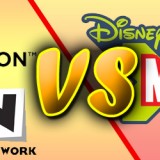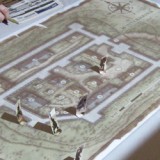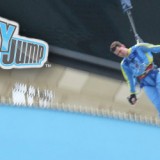Speakeasy Society’s The Johnny Cycle – Haunted, Haunting, Beautiful
The Speakeasy Society’s latest production, The Johnny Cycle is a remount of a prior 3-part series that ran in 2016-17. Performed in and throughout the stately Mountain View Mausoleum, the version I was treated to combined and reimagined the trilogy’s events into a single two-hour experience that took participants on a poignant, branching journey through the tragic story of a fictional WWI soldier. In it, we (the audience) are all Johnny, wandering through our own thoughts and memories.
Based on a “True” Story
Like their previous endeavor, the impressive 10-part Kansas Collection series, The Johnny Cycle is loosely based on a notable work of early 20th-Century fiction: Johnny Got His Gun. But while you’ve probably heard of The Wizard of Oz – which served (along with its sequels) as the basis for the Kansas Collection – you may not be familiar with Dalton Trumbo’s award-winning anti-war novel from 1938.
But don’t let that stop you from going. The Johnny Cycle uses the book’s characters, plot, and author as a jumping-off point from which The Speakeasy Society takes things into very much original territory. Participants’ journeys take them backward and forward through time, between the corroded memories and fever dreams of a man who knows both that he is a fictional character, and just how much hell his creator has put him through. Thanks to Trumbo, the war was not kind to Johnny. In order to be an effective warning against the horrors of military conflict, Trumbo made Johnny lose his sight, his limbs, his face, his voice… and return home a ruined shell, imprisoned within his own body. The strain this places on his mind is evident in the confusing, meandering paths the audience takes as we explore the fragmented remnants of Johnny’s psyche.
All Time is All Time
One of the defining characteristics of the experience is that events are not experienced in chronological order. In truth whichever of the dozens of possible tracks you wind up on will ping-pong between Johnny’s story, Dalton’s life, and less-easily-categorized interactions seemingly without regard for any sort of linear flow. But that’s sort of the point. The embrace of timelessness feels like a nod both to just how broken Johnny is, and that the source material remains relevant eighty years after its publication. It is just as fair now to talk about the horrors of war and creators being hounded for politically-charged works as it was then. “All time is all time,” a phrase repeated throughout the show in different scenes and contexts, frequently calls this back to the audience’s attention.
The scenes vary in terms of format and structure, as well. Scenes with the full ensemble and audience move into sequences with small groups and one or two cast members, during which one or more participants may get pulled into a one-on-one before linking back up with the others in the next full-cast scene. While the different paths have some overlap in terms of content, participants wanting to get the full story will need multiple visits in order to see everything. The branching, fluid narrative also helps reinforce the feeling of being adrift in time and space – we never really know where, or when, we’re going next. One scene might be a party with Dalton, only for the next to jump to Johnny in a wheelchair, waiting in quiet desperation for the nurse to return and give us some proof we exist. Admittedly the experience’s time-hopping flow can make the story hard to follow, and this may prove vexing for those who need to know what’s going on in order to maintain immersion. In my view, it’s best to go with the flow and let those insights emerge organically.
What Do You Want?
The question “what do you want” is another key refrain throughout. The characters’ various answers form the core of several scenes, including one in particular that I won’t spoil except to say that it – the lantern scene – is one of my favorites. It also got asked of me at a few points, though what I said rarely mattered. Instead, even in scenes during which I was speaking as Johnny, I was told what to say, word by word, even in answer to that specific question. But that fits for both the format – a low-agency walk – and the narrative. So much gets asked of us as Johnny, at all stages of “our” lives, but rarely does anyone really care what Johnny wants. And even when they ask, the answer almost never matters. For Johnny, and by extension, the participants, have no meaningful control over their destiny. We just do as we’re told, until and long after it ruins us.
This lack of participant agency means that the show hangs largely on scripted performances, but the cast delivers. There are no weak links, but I did have a few stand-outs on the path I traveled. Matthew Bamberg-Johnson (Dalton Trumbo) and Robert Paterno (Dalton’s friend) brought fiery performances: Bamberg-Johnson sold us on Trumbo’s desperation to have his work recognized and understood, while Paterno was in some ways his opposite, but equal, in fear of the consequences of Dalton’s obsession. And I wish I’d gotten to see more of Jenny Curtis (Dalton’s mother), who had a commanding monologue in one of the experience’s pivotal scenes. The cast brought the experience to life, deftly shifting between personae as people from Johnny’s memory, narrators of Johnny’s internal monologue, and more abstract embodiments of concepts like duty, desire, and death.
I Am the Grass, and I Cover All
In fact, death in one form or another is omnipresent throughout The Johnny Cycle. Which is to be expected given the source material; after all, this is a story about an anti-war novel and the trials faced by its Communist author. We see the death of relationships, of friendships, of Dalton’s career, and of people. An interpretive dance version of death, mind you – there’s no gore here.
But death is also a literal, physical presence as we walk the cold marble corridors of the mausoleum, a perfect match for the show. The Speakeasy Society makes expert use of the venue’s rooms when choosing the setting for scenes from Dalton’s and Johnny’s lives, and the sequences during which we wander the halls are lent extra gravity by having us surrounded by the reverently interred.
Follow Me, Johnny
The Johnny Cycle left me with a lot to process, and I’m sure I missed plenty even after comparing notes with fellow participants. The Speakeasy Society has put together a remarkably intricate and poignant story, with a great cast and a location that fits the story like a glove. Those with mobility impairments may want to reach out to the company before booking, as the experience covers a fair bit of ground over its two hours. But it’s worth seeing for the novel approach to storytelling, flawless pairing of script with venue, and talented ensemble. Ultimately The Johnny Cycle takes a bit of esoteric American literature and transforms it into a rich, complex tapestry of hope, conflict, and grief that is one of the most interesting immersive theater productions I’ve ever seen.
The Johnny Cycle runs through September 21st on Thursday, Friday, and Saturday nights from 8:00-10:30 at the Mountain View Mausoleum in Alta Dena, CA. Tickets are available for purchase here.
To learn more about The Speakeasy Society, visit their website or follow them on Facebook, Twitter, or Instagram.


















